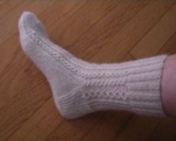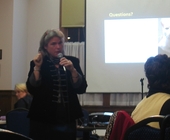
To get started, I suggest you get some needles, usually size 2 or 3, either double-pointed (DPNs) or a nice 32" circular needle (for Magic Loop) and some fingering (sock) weight yarn in a light color - very dark yarn can make it hard to see your stitches. You'll need about 400 yards to make a pair of socks, so check the yardage -some yarns come with enough to make a pair, others you'll need to buy two skeins. Washable is a very good quality in a sock yarn (that's a hint).
If you're comfortable doing so, cast on 72 stitches. I prefer a cable cast-on, but you can use any kind you like, as long as it can stretch. You'll be knitting in the round, so next, join without twisting. If you need help with joining, bring your work in and we'll get you started.
Begin working a ribbing pattern of your choice: K2, P2 is a nice basic one, but you can also do K1, P1, or K3, P1, or K2, P1, your choice. Any of those will work if you have cast on 72 stitches. You want to knit about an inch of this ribbing. When you're happy with your ribbing length, go ahead and begin straight stockinette knitting around for this first sock. If you just have to get fancy, go with a lace or cable pattern of your choice, or just continue ribbing (I often knit a whole sock in K3, P1 ribbing). Knit it until it measures the length of your hand from your wrist to the tip of your longest finger. Now you're ready for the heel. Bring it to the help table and we'll get started on the heel flap. See you soon!
If you'd like a good book about sock knitting, get a copy of The Sock Knitter's Handbook (available in print and as a downloadable PDF) from Martingale Press.
~Barb Simonds



 RSS Feed
RSS Feed
